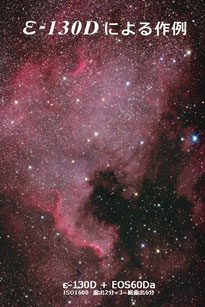Stock photos provided by the manufacturers may not represent the actual item. Please verify this picture accurately reflects the product described by the title and description before you place your order.
Takahashi Epsilon 130D Astrograph
- Manufacturer: Takahashi
- MPN: TEK13010
- SKU: TEK13010
- Last price was: $2,990.00
-
Availability: Backorder
Click here if you want to be notified as soon as we get this product in stock again.
Takahashi introduced their Epsilon Series flat-field hyperbolic astrographs in the middle 1980’s. The Epsilon-130 was the smallest aperture and most portable of the series. Now Takahashi is re-introducing the new E-130D digital version of this astrograph.
The Epsilon optical system features a hyperbolic primary and a digital corrector to produce a flat field image. Takahashi has been producing hyperbolic mirrors since 1985 and has a reputation for producing high quality hyperbolic astrographs like the current E-180ED.
The new E-130D is the same size as the original E-130 and was designed with an improvement in optical performance with a newly designed digital corrector. This produces an improvement in sharpness and a 1/3rd improvement in the size of the spot equaling the E-180 with <10µm spots at the edge of the Ø44mm circle.
The improvement in the design of the digital corrector produces a 1/3rd reduction in the size of the smallest stellar image. Distortion has also been reduced by ½ with the new design of the digital corrector used on the E-130D.
The E-130D has a 5.9° field of view that is perfect for imaging comets like the new comet ISON. With a speed of f/3.3 and a 430mm focal length images will be high contrast the E-130D will shorten exposures, increase color saturation and produce a wide field high performance images.
With an f/3.3 system the speed necessitates a large secondary that will illuminate the image properly. Placing the diagonal mirror in the center of the tube will produce uneven illumination across the field imaged. In order to fully illuminate the image circle the secondary must be offset to accept the full light cone produced by the primary mirror. The spider was specially strengthened to hold the mirror offset securely without any flexure. The focuser has been improved to allow or more precise focusing. Each has a metal insert with a special non-cold flow material to allow for the precise focus.
The E-130D features a new collimation system for the primary mirror, which is similar to the one used on the TOA. The previous design used push and pull screws set inside of each other. This modified system used separate push and pull adjusting screws. This flush design prevents the tube from being bumped because the protruding alignment bolts of the old design protruded past the end of the tube.
The E-130D is a highly portable, airline transportable, compact hyperbolic flat field astrograph that weighs only 10.8lbs that can be taken easily to remote sites or around the world. Its light weight and 5.9° apparent field of view make it perfect for comets and wide field imaging. Its light weight allows it to be carried by smaller and lighter high quality mounts.
E-130D Specifications
Optical configuration Hyperbolic - flat field astrograph
Effective aperture Ø130mm
Focal length 430mm [16.9”]
Focal ratio f/3.3
Image circle Ø44mm [5.9° field of view]
Minor axis of diagonal Ø63mm
Tube length 460mm [18.1”]
Weight 4.9kg [10.8lbs]
Tube diameter Ø166mm



